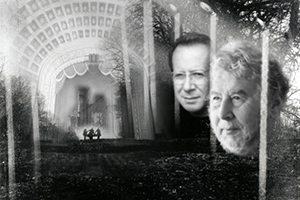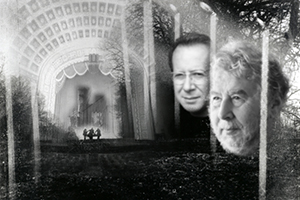For those who groove on ominous and obsessive, Hertz Hall on the UC Berkeley was the place to be as David Milnes and his Eco Ensemble began playing Harrison Birtwistle’s Secret Theater. After intermission, Ivan Fedele’s score helped make things even more unsettling as it accompanied Jean Epstein’s 65-minute silent film of 1928, La Chute de la Maison Usher (The fall of the House of Usher).
Fedele, an Italian academic reportedly much admired by the French modernist composer and conductor Pierre Boulez, was there in person to receive considerable applause at the end of the concert. Instead of walking up front to receive accolades, however, he should have popped out of a coffin like the one that dominated the film based on Edgar Allen Poe’s story about slow death, deranged obsessions, and live burial. Fedele’s music did just what it was supposed to do — give me an hour of the creeps.

What was it about the music that was so effective in troubling listeners and developing an atmosphere of foreboding? With Birtwistle, it was the contrast of one group of instruments (mostly woodwinds) continually playing characteristic melodies on one side of the stage — angular, not especially happy ones — while another group of instruments (primarily strings, brass, and percussion) played mostly gruesome rhythmic gestures.
The figures sounded at seemingly unpredictable and instrumentally independent intervals, only rarely related to any beat in the melodic line, but with just enough relation to the line to keep you poised in anticipation of the occasional concurrence. Then instruments would come up and join the melodic group from time to time, abandoning their previous roles in the “gesture” group and take up another weird melody.
Strong punctuations from percussionists would gradually increase in frequency, like madmen trying to get out of their asylum, leading to periodic climaxes every five minutes or so. And there was no relief from the delicious agony, for the brief respites would only lead to a subsequent, stronger buildup of instrumental density and beat intensity. Like the torturer who keeps victims conscious by throwing water in their face, Birtwistle’s fiendish variety, with just enough predictability to make you want to keep anticipating what might happen next, kept you so absorbed in the project there was no hope for escape.
Fedele’s music did just what it was supposed to do — give me an hour of the creeps. Semipredictable blows and anguished semi-tunes, conjured by genius, made for an unforgettable new-music experience. Never have I so craved being disturbed again after the nearly 30-minute masterpiece subsided away.
The foreboding in Fedele’s music was not as structural or rhythmic as Birtwistle’s. Rather, it was focused on tone color and hollow dissonances. It was more subdued, underpinning Epstein’s striking images in the best possible way. Most recently, composed music I’ve heard for silent films becomes too repetitive, as if the composer had run out of things to say, or had become a slave to images that he or she had decided must receive the same leitmotiv or treatment in the score every time they recur. Not so with Fedele: His music was largely independent of the action on the screen, except for slight pauses between sections. Yet it was consistent in mood and never seemed out of place. Nor did it threaten to overwhelm — the focus was rightly put on the screen.Throughout both selections, the Eco Ensemble performed admirably some very difficult music.
That focus, however, was also the drawback of some of the music. When images were not so striking, when attention lagged visually, the music wasn’t enough to enjoy on its own. I can’t imagine listening to more than 10 minutes of Fedele’s music without Epstein’s film to catalyze it. The two are inextricably wedded and should not be separated.
Throughout both selections, the Eco Ensemble performed admirably some very difficult music. I am grateful that Milnes is bringing the music of Birtwistle and Fedele to West Coast attention.

